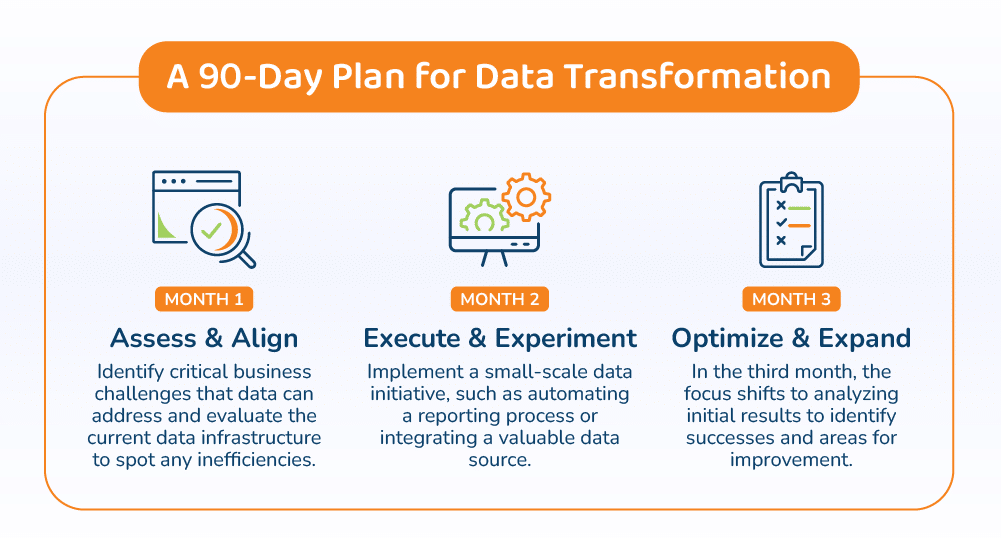The Data Transformation Roadmap: A Practical Guide for Building a Data-Driven Enterprise
This guide walks CEOs through a practical roadmap—aligning strategy, technology, people, and processes to build a truly data-driven enterprise.
Table of Content
Data has become the ultimate business advantage, but many companies fail to see meaningful ROI despite massive investments in analytics, AI, and cloud platforms. Why? Because technology alone doesn’t drive transformation—leadership does.
Without a clear roadmap, companies end up with scattered analytics tools, underutilized dashboards, and fragmented decision-making. CEOs must own the data transformation strategy, ensuring that data isn’t just collected—but actively shapes business decisions, fuels innovation, and gives teams a competitive edge.
This guide outlines a simple, practical approach to turning raw data into real business value, focusing on execution, leadership, and long-term success.
Most organizations start with technology. We think that’s a mistake. A true data transformation begins with strategy—aligning business objectives with data priorities. Before adopting new tools, ask the right questions:
Leadership in action: When Mary Barra transformed General Motors, she didn’t start with AI or predictive analytics—she started by aligning GM’s data strategy to real-world business priorities like electric vehicle adoption, supply chain resilience, and customer demand forecasting.
Action step for CEOs: Schedule a data strategy session with business leaders—not just IT. Identify where data gaps slow decision-making and define success metrics.
Once your strategy is clear, build the infrastructure to support it. But be careful—fragmented tools lead to fragmented insights.
What to evaluate:
Leadership in action: Retail giant Nike successfully unified its supply chain, sales, and customer data across regions by shifting to a cloud-based, integrated data platform. The result? Faster inventory management and data-driven insights that boosted eCommerce revenue substantially.
Action step for CEOs: Audit your existing tech stack—identify where data is siloed and create a roadmap for integrating disconnected systems.
Data transformation fails without adoption. If employees don’t trust or understand the data, it’s useless.
Leadership in action: Satya Nadella redefined Microsoft’s culture by pushing data democratization—empowering every team, from marketing to finance, to make decisions based on real-time insights. This shift fueled Microsoft’s transition from a stagnant software company to a cloud and AI leader.
Action step for CEOs: Create a cross-functional data team that includes business leaders, not just IT, to drive adoption.
Outdated processes can slow even the best data initiatives. When teams struggle with manual reporting, inconsistent data, or disconnected workflows, valuable insights get lost in the noise. Optimizing processes ensures data flows efficiently across the organization, empowering employees to act on insights in real time.
Leadership in action: Danone is shaking up its supply chain with a major AI-driven transformation in partnership with Microsoft. By leveraging predictive forecasting and real-time analytics, the company is fine-tuning production and logistics, helping teams make smarter, faster decisions. With digital twins simulating core operations, Danone’s procurement and distribution teams now have data-driven insights at their fingertips, allowing them to stay agile in a rapidly evolving market.
Action step for CEOs: Identify three manual workflows in your organization that could be automated this quarter.
Data transformation is an ongoing journey, not a one-time project. To ensure long-term success, organizations must track progress, refine strategies, and evolve their approach as business needs change.
Leadership in action: Levi Strauss & Co. used Google Cloud analytics to spot a surge in demand for baggy jeans across customer segments. By integrating data from purchases, web browsing, and retail partners, the company adjusted inventory, launched targeted campaigns and capitalized on the trend—boosting loose-fit jeans sales by 15% in a single quarter.
Action step for CEOs: Choose three key business metrics to track over the next 90 days and set a recurring leadership review to evaluate data-driven improvements.

While data transformation is an ongoing effort, taking immediate, structured action can jumpstart progress. Below is a simple, practical 90-day roadmap to help build momentum. The 90-day timeframe isn’t important—your journey may take longer, and that’s just fine. What’s important is progress toward your goals.
By taking structured, incremental steps, your organization can build a strong foundation for long-term data transformation. The key is progress over perfection—refining strategies as you go while keeping an eye on long-term value.
Building a data-driven enterprise isn’t a one-time project—it’s an ongoing journey of transformation, optimization, and continuous learning. The most successful organizations don’t just collect data. They make it accessible, actionable, and aligned with their business goals.
By following this roadmap—defining your data strategy, investing in the right technology, empowering your people, optimizing processes, and continuously refining your approach—you’ll create a culture where data fuels every decision, unlocking new opportunities for growth and innovation.
The good news? You don’t have to tackle this alone. Whether you’re evaluating your current systems, considering a move to the cloud, or looking for guidance on maximizing your data investments, our team of experts is here to help. Contact us today.
Talk to us about how Velosio can help you realize business value faster with end-to-end solutions and cloud services.
"*" indicates required fields